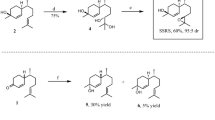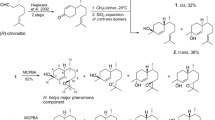Abstract
Verbenone andtrans-verbenol were investigated as candidate interruptants for use as tree protectants. Verbenone andtrans-verbenol, pheromones released byDendroctonus brevicomis during host colonization, reduced the trap catch ofD. brevicomis near sources of the attractant composed ofexo-brevicomm, frontalin, and myrcene. Catch reduction at some trap positions was greater at a high release rate than at a low release rate oftrans-verbenol alone and of the combination of verbenone plustrans-verbenol. Verbenone also reduced catches at traps baited with attractive bolts from trees under attack byD. brevicomis. Attempts to use verbenone to protect living trees fromD. brevicomis attack were inconclusive.
Similar content being viewed by others
References
Bedard, W.D., andBrowne, L.E. 1969. A delivery-trapping system for evaluating insect chemical attractants in nature.J. Econ. Entomol. 62:1202–1203.
Bedard, W.D., Wood, D.L., Tilden, P.E., Lindahl, K.Q., Silverstein, R.M., andRodin, J.O. 1980. Field response of the western pine beetle and one of its predators to host- and beetle-produced compounds.J. Chem. Ecol. 6:625–641.
Browne, L.E. 1978. A trapping system for the western pine beetle using attractive pheromones.J. Chem. Ecol. 4:261–275.
Browne, L.E., Wood, D.L., Bedard, W.D., Silverstein, R.M., andWest, J.R. 1979. Quantitative estimates of the western pine beetle pheromone components,exo-brevicomin, frontalin, and myrcene in nature.J. Chem. Ecol 5:397–414.
Dickens, J.C., andPayne, T.L. 1977. Bark beetle olfaction: Pheromone receptor system inDendroctonus frontalis. J. Insect Physiol. 23:481–489.
Furniss, M.M., Daterman, G.E., Kline, L.N., McGregor, M.D., Trostle, G.C., Pettingeh, L.F., andRudinsky, J.A. 1974. Effectiveness of the Douglas-fir beetle anti-aggregative pheromone methyleyclohexenone at three concentrations and spacings around felled trees.Can. Entomol. 106:381–392.
Hughes, P.R., andPitman, G.B. 1970. A method for observing and recording the flight behavior of tethered bark beetles in response to chemical messengers.Contrib. Boyce Thompson Inst. 24:329–336.
Lehmann, E.L., 1975. Nonparametrics: Statistical Methods Based on Ranks. Holden-Day, Inc., San Francisco. 457 pp.
Libbey, L.M., Morgan, M.E., Putnam, T.B., andRudinsky, J.A. 1974. Pheromones released during inter-and intra-sex response of the scolytid beetleDendroctonus brevicomis.J. Insect Physiol. 20:1667–1671.
Mehra, K.L., andSarangi, J. 1967. Asymptotic efficiency of certain rank tests for comparative experiments.Ann. Math. Statist. 38:90–107.
Miller, R.G. 1966. Simultaneous Statistical Inference. McGraw-Hill, Inc., New York. 272 pp.
Pitman, G.B., Vité, J.P., Kinzer, G.W.,andFentiman, A.F., Jr. 1968. Bark beetle attractants:trans-Verbenol isolated fromDendroctonus.Nature 218:168–169.
Pitman, G.B., Vite, J.P., Kinzer, G.W., andFentiman, A.F., Jr. 1969. Specificity of population-aggregating pheromones inDendroctonus.J. Insect Physiol. 15:363–366.
Renwick, J.A.A. 1967. Identification of two oxygenated terpenes from thes bark beetlesDendroctonus frontalis andDendroctonus brevicomis.Contrib. Boyce Thompson Inst. 23:355–360.
Renwick, J.A.A., andVitÉ, J.P. 1970. Systems of chemical communication inDendroctonus. Contrib. Boyce Thompson Inst. 24:283–292.
Richerson, J.V., andPayne, T.L. 1979. Effects of bark beetle inhibitors on landing and attack behavior of the southern pine beetle and beetle associates.Environ. Entomol. 8:360–364.
Rudinsky, J.A. 1973. Multiple functions of the southern pine beetle pheromone verbenone.Environ. Entomol. 2:511–514.
Rudinsky, J.A., Sartwell, C., Jr., Graves, T.M., andMorgan, M.E. 1974a. Granular formulation of methyleyclohexenone: An anti-aggregative pheromone of the Douglas-fir and spruce bark beetles (Col., Scolytidae).Z. Angew. Entomol. 75:254–263.
Rudinsky, J.A., Morgan, M.E., Libbey, L.M., andPutnam, T.B. 1974b. Antiaggregative rivalry pheromone of the mountain pine beetle and a new arrestant of the southern pine beetle.Environ. Entomol. 3:90–98.
Rudinsky, J.A., Ryker, L.C., Michael, R.R., Libbey, L.M., andMorgan, M.E. 1976. Sound production in Scolytidae: female sonic stimulus of male pheromone release in twoDendroctonus beetles.J. Insect Physiol. 22:1675–1681.
Sen, P.K. 1968. On a class of aligned rank order tests in two-way layouts.Ann. Math. Statist. 39:1115–1124.
Tilden, P.E., Bedard, W.D., Wood, D.L., Lindahl, K.Q., andRauch, P.A. 1979. Trapping the western pine beetle at and near a source of synthetic attractive pheromone: Effects of trap size and position.J. Chem. Ecol. 5:519–531.
Tukey, J.W. 1962. The future of data analysis.Ann. Math. Statist. 33:1–67.
Wood, D.L. 1977. Manipulation of forest insect pests, pp. 369–384,in H.H. Shorey and J.J. McKelvey, Jr. (eds.). Chemical Control of Insect Behavior. John Wiley & Sons, New York. 414 pp.
Author information
Authors and Affiliations
Additional information
Coleoptera: Scolytidae.
This research was supported in part by the Forest Service, U.S. Department of Agriculture, and in part by grants from the National Science Foundation/Environmental Protection Agency (grant NSF-6B-34718/BMS75-04223), and in part by grants from the Rockefeller Foundation to the University of California. Mention of a proprietary or commercial product does not constitute recommendation or endorsement of the product by the U.S. Department of Agriculture and does not imply its approval to the exclusion of other products that also may may be suitable.
Rights and permissions
About this article
Cite this article
Bedard, W.D., Tilden, P.E., Lindahl, K.Q. et al. Effects of verbenone andtrans-verbenol on the response ofDendroctonus brevicomis to natural and synthetic attractant in the field. J Chem Ecol 6, 997–1013 (1980). https://doi.org/10.1007/BF00994657
Received:
Revised:
Issue Date:
DOI: https://doi.org/10.1007/BF00994657




